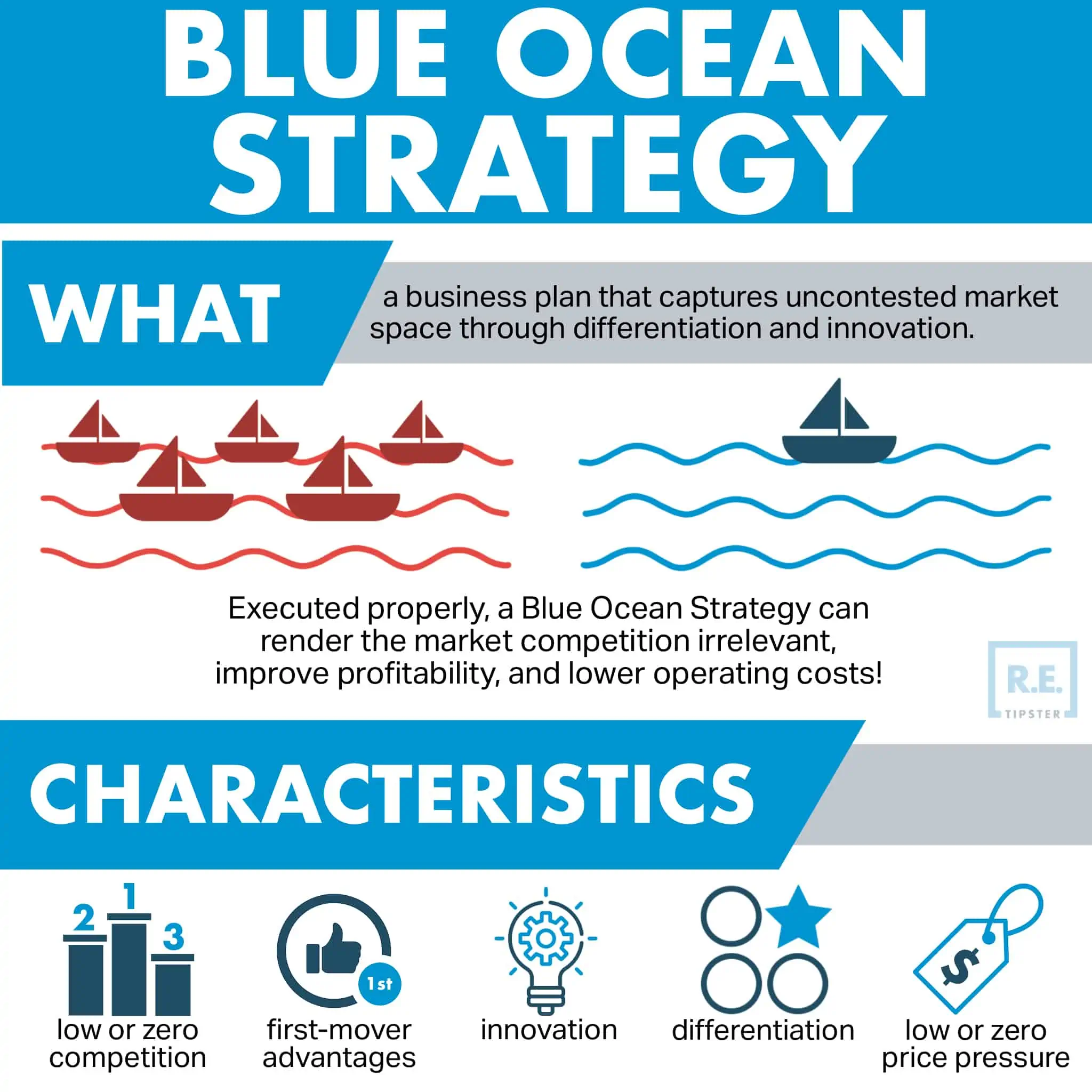What Is the Blue Ocean Strategy?
REtipster does not provide tax, investment, or financial advice. Always seek the help of a licensed financial professional before taking action.
Origins of the Blue Ocean Strategy
The concept behind the strategy is that a business should concentrate on finding new market space and reinventing the industry.
In other words, it advocates avoiding head-to-head competition in an already saturated market and focusing on innovation and differentiation to attract newer market segments. Ideally, the Blue Ocean Strategy results in a decisive advantage within the industry and low pricing pressure.
The Blue Ocean strategy is the brainchild of W. Chan Kim and Rénee Mauborgne, both Professors of Strategy at INSEAD Business School. They are also co-directors of the INSEAD Blue Ocean Strategy Institute, headquartered in Fontainebleau, France.
Their 2005 book, Blue Ocean Strategy[1], described the concept as a method to create uncontested market space and make the competition irrelevant.
The strategies described in Blue Ocean Strategy are based on a study of 150 strategic moves executed by industry leaders like Apple, Air Asia, Yellow Tail, and Cirque de Soleil over the last 100 years[2]. Today, the book is a global bestseller and has been adopted by over 2.800 universities. It remains a go-to resource in the business leadership and economic thinking spheres.
How Does the Blue Ocean Strategy Work?
In established industries, competition is often so intense that many companies can no longer sustain themselves. As a result, companies often have to sacrifice profitability and growth to gain and control market share, like resorting to price cuts to attract more customers.
This system creates a ripple effect across the industry by pressuring competitors to lower their prices as well if they want to stay competitive. As a result, the industry itself becomes limited.
These characteristics perfectly describe a “red ocean” situation. The market is heavily saturated with competition and bloodied by all the efforts companies make to stay afloat[3]. Under such conditions, there is little room to grow, so companies must find ways to acquire new demand and access uncontested market share.
What Is in a Blue Ocean?
The term blue ocean refers to the vast, empty ocean of market options and opportunities that organizations can tap into by moving into a less-crowded marketplace. It represents the unknown market space the company executing the strategy aims to unlock.
In a blue ocean, there is potential for higher profits. Competition, if any, is not so relevant because the rules of the game are yet to be defined. With all that open market space waiting to be explored, a business has more freedom to move around, test new ideas, and carve out new niches to help them scale faster.
Rather than allocating resources to compete for what little demand remains in an overcrowded red ocean, the Blue Ocean Strategy directs resources toward finding an uncontested marketplace and creating demand. The goal is to break away from the pack while cutting costs so there is more profit and ample room for growth.
Market Disruption: An Example
One of the best ways to do this is to introduce products or services with superior features.
Consider the taxi industry. Competition is fierce and pricing is heavily regulated, a classic red ocean market.
Then ride-sharing services like Uber and Lyft came along and disrupted the market[4].
The market welcomed their innovative features: comfortable ride on demand, ability to track the journey, and exclusive discounts and rebates. Together, their services carved out a new market segment from the bloated red ocean of the taxi industry, effectively making the competition irrelevant and setting their businesses on the path to profitable growth.
Unlike many business and leadership strategy theories, the Blue Ocean Strategy is deeply rooted in real-world cases across more than 30 industries over the last century. Some examples of companies that masterfully applied the four-action framework (other than Uber and Lyft described above) include Netflix, Nintendo, and Airbnb[5].
The Four-Action Framework of the Blue Ocean Strategy
Many organizations followed the four-action framework[6] when applying the blue ocean strategy. These principles allow companies to break the trade-off between differentiation and low cost and translate market insights into a well-defined, practical approach.
The four action points are:
- Raise —What factors can be raised above the industry standard?
- Reduce — What factors can be reduced or lowered below the industry standard?
- Eliminate — What factors or features can be eliminated?
- Create — What new features can be created to steer the company into less-saturated waters?
The answers to these four questions are keys to implementing a winning strategy.
Characteristics of Blue Oceans
- Low or zero competition — There are no competitors in a pure blue ocean market. Even if competition is present, the company still holds the strongest competitive advantage.
- First-mover advantages — Companies that create and operate in uncontested markets get to make the rules. They also have the flexibility to take their offering in various directions in line with their growth goals.
- Innovation — Products offered in the new market should mix good value and affordable prices.
- Differentiation — In this instance, the goal is not to outshine the competition but to make it useless by moving into a new market space.
- Low or zero price pressure — Operating in a blue ocean market means companies can set prices without competitive constraints.
What Is Needed to Change Red Oceans to Blue Oceans?
Moving from the red, tainted waters of bloody competition to the blue oceans of uncontested markets requires three key components:
- Perspective — Applying the blue ocean strategy begins with having the right mindset. The organization’s main movers should broaden their mental horizons and shift their focus toward identifying viable opportunities.
- Roadmap — Breaking away from the pack to establish a new marketplace requires a well-defined process and the right tools.
- Confidence — Every successful blue ocean strategy requires a degree of “human-ness,” a humanistic process that builds people’s confidence to drive and own the process at every stage of the execution.
The Five-Step Process
Blue Ocean Strategy also references a five-step process to reproduce the strategy. These steps are:
- Choose the right place to start. This involves figuring out the ideal starting point to introduce innovative new offerings and then putting together the right blue ocean team.
- Get clear about the current state of the team. This involves assessing the current team’s strengths and weaknesses, and working out ways to improve them.
- Identify customer pain points. This involves uncovering any areas limiting the customer experience.
- Reconstruct market boundaries. Develop superior product or service features to address these pain points uniquely.
- Make the shift. This involves writing a formal action plan, conducting rapid market tests to gauge the viability of the new product/service features, and launching the shift toward the blue ocean market space.
Takeaways
- The Blue Ocean Strategy is a method of capturing uncontested market space and rendering competition irrelevant through differentiation and innovation.
- It is so-called to refer to the vast, open ocean of opportunities that organizations can tap into and enjoy greater profitability. This is in contrast to a red ocean, which is “bloodied” by intense competition and limited room for growth.
- The strategy is focused on innovation, differentiation, and low cost, as opposed to taking on competition head-on to fight for available market share.
- One of the best ways to implement a Blue Ocean Strategy is to offer valuable upgrades to existing products or services or a new way to deliver the same services. A blue ocean strategy may disrupt the industry, as in the case of Uber and Netflix.
Sources
- The Blue Ocean Strategy. (n.d.) ABOUT THE BOOK: BLUE OCEAN STRATEGY. Retrieved from https://www.blueoceanstrategy.com/books/blue-ocean-strategy-book/
- Yonder. (n.d.) 3 examples of blue ocean strategy. Retrieved from https://yonderconsulting.com/3-examples-blue-ocean-strategy/
- The Blue Ocean Strategy. (n.d.) WHAT ARE RED AND BLUE OCEANS? Retrieved from https://www.blueoceanstrategy.com/what-are-red-blue-oceans/
- Horn, M. (2016.) Uber, Disruptive Innovation And Regulated Markets. Forbes. Retrieved from https://www.forbes.com/sites/michaelhorn/2016/06/20/uber-disruptive-innovation-and-regulated-markets/?sh=7538816737fb
- Mayka, K. (2021.) Blue Ocean Strategy: Grow Your Business Without Having to Compete. Eleken. Retrieved from https://www.eleken.co/blog-posts/blue-ocean-strategy-grow-your-business-without-having-to-compete
- Cuofano, G. (2022.) What Is The Four Actions Framework And Why It Matters In Business. Four-Week MBA. Retrieved from https://fourweekmba.com/four-actions-framework/








